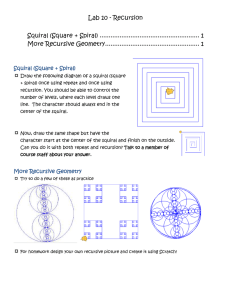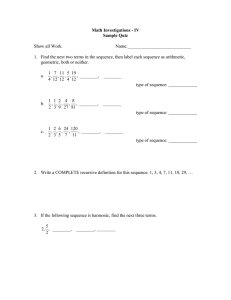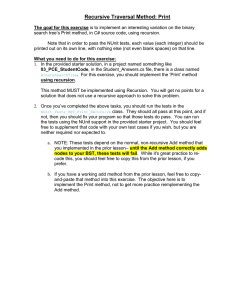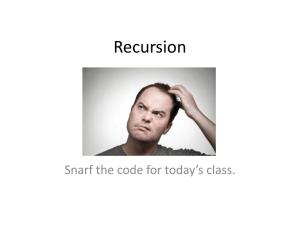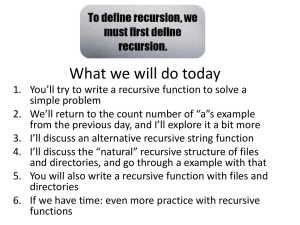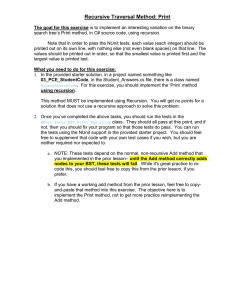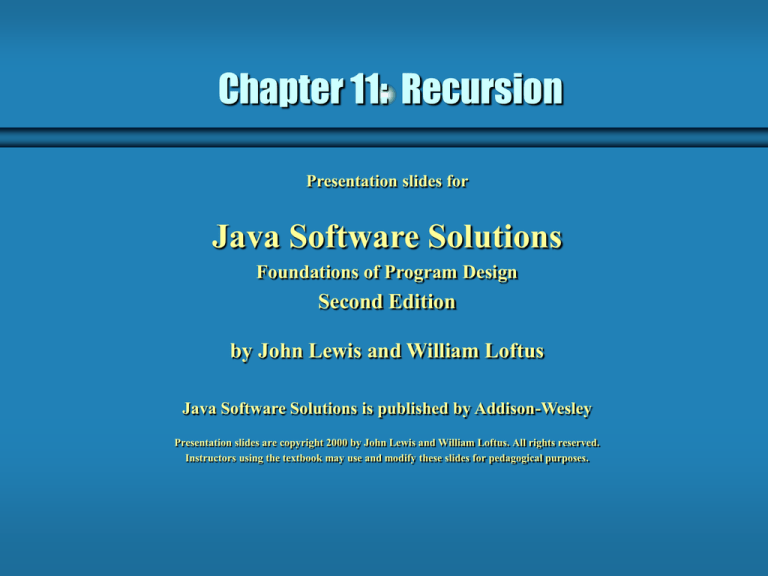
Chapter 11: Recursion
Presentation slides for
Java Software Solutions
Foundations of Program Design
Second Edition
by John Lewis and William Loftus
Java Software Solutions is published by Addison-Wesley
Presentation slides are copyright 2000 by John Lewis and William Loftus. All rights reserved.
Instructors using the textbook may use and modify these slides for pedagogical purposes.
Recursion
Recursion is a fundamental programming technique that
can provide an elegant solution certain kinds of problems
Chapter 11 focuses on:
•
•
•
•
thinking in a recursive manner
programming in a recursive manner
the correct use of recursion
recursion examples
2
Recursive Thinking
A recursive definition is one which uses the word or concept
being defined in the definition itself
When defining an English word, a recursive definition is
often not helpful
But in other situations, a recursive definition can be an
appropriate way to express a concept
Before applying recursion to programming, it is best to
practice thinking recursively
3
Recursive Definitions
Consider the following list of numbers:
24, 88, 40, 37
Such a list can be defined as
A LIST is a:
or a:
number
number
comma
LIST
That is, a LIST is defined to be a single number, or a
number followed by a comma followed by a LIST
The concept of a LIST is used to define itself
4
Recursive Definitions
The recursive part of the LIST definition is used several
times, terminating with the non-recursive part:
number comma LIST
24
,
88, 40, 37
number comma LIST
88
,
40, 37
number comma LIST
40
,
37
number
37
5
Infinite Recursion
All recursive definitions have to have a non-recursive part
If they didn't, there would be no way to terminate the
recursive path
Such a definition would cause infinite recursion
This problem is similar to an infinite loop, but the nonterminating "loop" is part of the definition itself
The non-recursive part is often called the base case
6
Recursive Definitions
N!, for any positive integer N, is defined to be the product
of all integers between 1 and N inclusive
This definition can be expressed recursively as:
1!
N!
=
=
1
N * (N-1)!
The concept of the factorial is defined in terms of another
factorial
Eventually, the base case of 1! is reached
7
Recursive Definitions
120
5!
24
5 * 4!
6
4 * 3!
3 * 2!
2
2 * 1!
1
8
Recursive Programming
A method in Java can invoke itself; if set up that way, it is
called a recursive method
The code of a recursive method must be structured to
handle both the base case and the recursive case
Each call to the method sets up a new execution
environment, with new parameters and local variables
As always, when the method completes, control returns to
the method that invoked it (which may be an earlier
invocation of itself)
9
Recursive Programming
Consider the problem of computing the sum of all the
numbers between 1 and any positive integer N
This problem can be recursively defined as:
N
N-1
=
N
i=1
=
+
N-2
=
i=1
N + (N-1) +
i=1
etc.
10
Recursive Programming
result = 6
main
sum(3)
sum
result = 3
sum(2)
sum
result = 1
sum(1)
sum
11
Recursive Programming
Note that just because we can use recursion to solve a
problem, doesn't mean we should
For instance, we usually would not use recursion to solve
the sum of 1 to N problem, because the iterative version is
easier to understand
However, for some problems, recursion provides an elegant
solution, often cleaner than an iterative version
You must carefully decide whether recursion is the correct
technique for any problem
12
Indirect Recursion
A method invoking itself is considered to be direct recursion
A method could invoke another method, which invokes
another, etc., until eventually the original method is
invoked again
For example, method m1 could invoke m2, which invokes
m3, which in turn invokes m1 again
This is called indirect recursion, and requires all the same
care as direct recursion
It is often more difficult to trace and debug
13
Indirect Recursion
m1
m2
m3
m1
m2
m1
m3
m2
m3
14
Maze Traversal
We can use recursion to find a path through a maze
From each location, we can search in each direction
Recursion keeps track of the path through the maze
The base case is an invalid move or reaching the final
destination
See MazeSearch.java (page 472)
See Maze.java (page 474)
Towers of Hanoi
The Towers of Hanoi is a puzzle made up of three vertical
pegs and several disks that slide on the pegs
The disks are of varying size, initially placed on one peg
with the largest disk on the bottom with increasingly
smaller ones on top
The goal is to move all of the disks from one peg to another
under the following rules:
• We can move only one disk at a time
• We cannot move a larger disk on top of a smaller one
Towers of Hanoi
An iterative solution to the Towers of Hanoi is quite
complex
A recursive solution is much shorter and more elegant
See SolveTowers.java (page 479)
See TowersOfHanoi.java (page 480)
Mirrored Pictures
Consider the task of repeatedly displaying a set of images in
a mosaic that is reminiscent of looking in two mirrors
reflecting each other
The base case is reached when the area for the images
shrinks to a certain size
See MirroredPictures.java (page 483)
18
Fractals
A fractal is a geometric shape made up of the same pattern
repeated in different sizes and orientations
The Koch Snowflake is a particular fractal that begins with
an equilateral triangle
To get a higher order of the fractal, the sides of the triangle
are replaced with angled line segments
See KochSnowflake.java (page 486)
See KochPanel.java (page 489)

